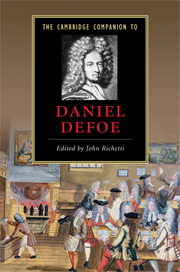Book contents
- Frontmatter
- Introduction
- 1 Defoe: the man in the works
- 2 Defoe’s political and religious journalism
- 3 Defoe, commerce, and empire
- 4 Defoe and criminal fiction
- 5 Money and character in Defoe’s fiction
- 6 Defoe’s Tour and the identity of Britain
- 7 Defoe as narrative innovator
- 8 Gender and fiction in Moll Flanders and Roxana
- 9 Defoe and London
- 10 Robinson Crusoe: varieties of fictional experience
- 11 Defoe: satirist and moralist
- 12 Defoe and poetic tradition
- Further Reading
- Index
9 - Defoe and London
Published online by Cambridge University Press: 28 March 2009
- Frontmatter
- Introduction
- 1 Defoe: the man in the works
- 2 Defoe’s political and religious journalism
- 3 Defoe, commerce, and empire
- 4 Defoe and criminal fiction
- 5 Money and character in Defoe’s fiction
- 6 Defoe’s Tour and the identity of Britain
- 7 Defoe as narrative innovator
- 8 Gender and fiction in Moll Flanders and Roxana
- 9 Defoe and London
- 10 Robinson Crusoe: varieties of fictional experience
- 11 Defoe: satirist and moralist
- 12 Defoe and poetic tradition
- Further Reading
- Index
Summary
“I BEGAN my Travels, where I Purpose to End them, viz. At the City of London ...” (Defoe, Tour I, 1) / Daniel Defoe began and ended his own travels, so to speak, in London, and the city of London is the implied or explicit setting, subject, or structuring principle of just about every work he wrote, didactic or fictional, prosaic or poetic. Cities in general fascinated Defoe, but he wrote most particularly of London, its boundaries and buildings, streets and occupations, trade and crime, strengths and vulnerabilities, ancient patterns and constant permutations. He knew it intimately and represented it vividly; however fictional the plots and characters of his novels might be, London is always precisely real. The streets are accurately mapped, the buildings reliably themselves. And yet, for Defoe, there are many Londons overlapping in those precisely drawn streets. There is the economically charged city, buoyant with trade, a city of shops and houses and traffic and merchants and apprentices and servants. But there are darker Londons with ragged children and forgotten elderly swept into corners, thieves lurking in the underworld, stockjobbers corrupting financial networks, watermen and hackney drivers imperiling the streets, plague and fire ravaging the whole. Places of safety and prosperity are simultaneously the spaces of danger and vulnerability. Defoe's London teems with contradictions and ambiguities and peculiar linguistic, social, and topographical codes - and he employs different genres to explore them.
- Type
- Chapter
- Information
- The Cambridge Companion to Daniel Defoe , pp. 158 - 181Publisher: Cambridge University PressPrint publication year: 2009

